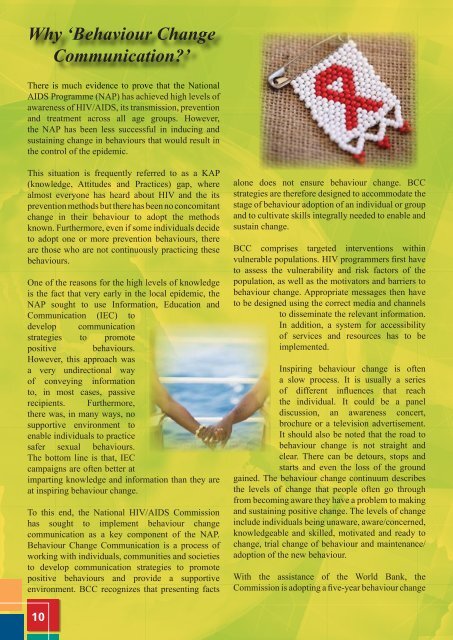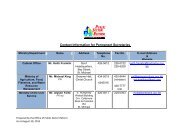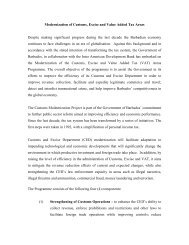PRDS Helping You To⦠- Office of Public Sector Reform
PRDS Helping You To⦠- Office of Public Sector Reform
PRDS Helping You To⦠- Office of Public Sector Reform
You also want an ePaper? Increase the reach of your titles
YUMPU automatically turns print PDFs into web optimized ePapers that Google loves.
Why ‘Behaviour Change<br />
Communication’<br />
There is much evidence e to prove that the<br />
National<br />
AIDS Programme (NAP) has achieved high levels <strong>of</strong><br />
awareness <strong>of</strong> HIV/AIDS, its transmission, prevention<br />
and treatment across all age groups. However,<br />
the NAP has been less successful in inducing and<br />
sustaining change in behaviours that would result in<br />
the control <strong>of</strong> the epidemic.<br />
This situation is frequently referred to as a KAP<br />
(knowledge, Attitudes and Practices) gap, where<br />
almost everyone has heard about HIV and the its<br />
prevention methods but there has been no concomitant<br />
change in their behaviour to adopt the methods<br />
known. Furthermore, even if some individuals decide<br />
to adopt one or more prevention behaviours, there<br />
are those who are not continuously practicing these<br />
behaviours.<br />
One <strong>of</strong> the reasons for the high levels <strong>of</strong> knowledge<br />
is the fact that very early in the local epidemic, the<br />
NAP sought to use Information, Education and<br />
Communication (IEC) to<br />
develop communication<br />
strategies to promote<br />
positive behaviours.<br />
However, this approach was<br />
a very undirectional way<br />
<strong>of</strong> conveying information<br />
to, in most cases, passive<br />
recipients. Furthermore,<br />
there was, in many ways, no<br />
supportive environment to<br />
enable individuals to practice<br />
safer sexual behaviours.<br />
The bottom line is that, IEC<br />
campaigns are <strong>of</strong>ten better at<br />
imparting knowledge and information than they are<br />
at inspiring behaviour change.<br />
To this end, the National HIV/AIDS Commission<br />
has sought to implement behaviour change<br />
communication as a key component <strong>of</strong> the NAP.<br />
Behaviour Change Communication is a process <strong>of</strong><br />
working with individuals, communities and societies<br />
to develop communication strategies to promote<br />
positive behaviours and provide a supportive<br />
environment. BCC recognizes that presenting facts<br />
alone does not ensure behaviour change. BCC<br />
strategies are therefore designed to accommodate the<br />
stage <strong>of</strong> behaviour adoption <strong>of</strong> an individual or group<br />
and to cultivate skills integrally needed to enable and<br />
sustain change.<br />
BCC comprises targeted interventions within<br />
vulnerable populations. HIV programmers first have<br />
to assess the vulnerability and risk factors <strong>of</strong> the<br />
population, as well as the motivators and barriers to<br />
behaviour change. Appropriate messages then have<br />
to be designed using the correct media and channels<br />
to disseminate the relevant information.<br />
In addition, a system for accessibility<br />
<strong>of</strong> services and resources has to be<br />
implemented.<br />
Inspiring behaviour change is <strong>of</strong>ten<br />
a slow process. It is usually a series<br />
<strong>of</strong> different influences that reach<br />
the individual. It could be a panel<br />
discussion, an awareness concert,<br />
brochure or a television advertisement.<br />
It should also be noted that the road to<br />
behaviour change is not straight and<br />
clear. There can be detours, stops and<br />
starts and even the loss <strong>of</strong> the ground<br />
gained. The behaviour change continuum describes<br />
the levels <strong>of</strong> change that people <strong>of</strong>ten go through<br />
from becoming aware they have a problem to making<br />
and sustaining positive change. The levels <strong>of</strong> change<br />
include individuals being unaware, aware/concerned,<br />
knowledgeable and skilled, motivated and ready to<br />
change, trial change <strong>of</strong> behaviour and maintenance/<br />
adoption <strong>of</strong> the new behaviour.<br />
With the assistance <strong>of</strong> the World Bank, the<br />
Commission is adopting a five-year behaviour change<br />
10

















